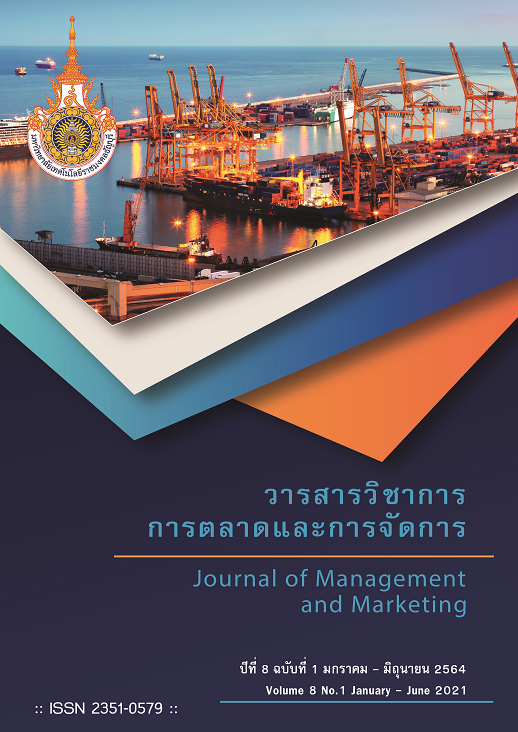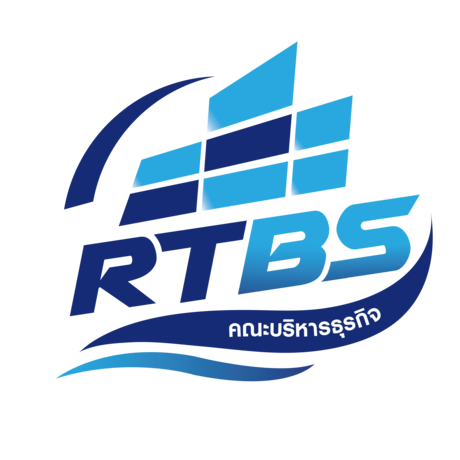อิทธิพลของการโพสต์ตราสินค้าและการไหลที่มีต่อความภักดีในตราสินค้าของผู้ใช้งานเฟซบุ๊กเพจโดยมีชุมชนตราสินค้าออนไลน์ในฐานะตัวแปรส่งผ่าน
คำสำคัญ:
การโพสต์ตราสินค้า, ชุมชนตราสินค้าออนไลน์, การไหล, ความจงรักภักดี, เฟซบุ๊กเพจบทคัดย่อ
งานวิจัยนี้ศึกษาและทดสอบโมเดลสมการโครงสร้างที่มีรูปแบบการโพสต์ ได้แก่ การให้ข้อมูล การสร้างความบันเทิง การให้สิทธิประโยชน์ และด้านสังคม และการไหล เป็นตัวแปรตั้งต้นที่ส่งผลทางอ้อมต่อระดับความภักดีในตราสินค้าโดยมีชุมชนตราสินค้าออนไลน์เป็นตัวแปรส่งผ่าน โดยมีกลุ่มเป้าหมายผู้ตอบแบบสอบถามได้แก่ สมาชิกผู้ติดตามเฟซบุ๊กที่เป็นทางการตราสินค้าอันเดอร์อารเมอร์อย่างน้อยเป็นระยะเวลาหนึ่งเดือน จากการเก็บได้กลุ่มตัวอย่างจำนวน 377 คน ผลการทดสอบโมเดลสมการโครงสร้างพบค่าดัชนีความสอดคล้อง (Fit Indices) ที่ยอมรับได้ คือ Chi-square = 438.438, Probability level = 0.00, CMIN/DF = 1.661, RMR = 0.027, RMSEA = 0.042, GFI = 0.916, CFI = 0.957 แสดงว่า อิทธิพลจากการโพสต์เฟซบุ๊กเพจส่งผลต่อความภักดีในตราสินค้า โดยมีระดับความเข้มแข็งในชุมชนตราสินค้าในสื่อสังคมออนไลน์ที่ทำการศึกษาเป็นตัวแปรส่งผ่าน เช่นเดียวกันกับการไหลของผู้ใช้งานฯ ที่ส่งผลต่อความภักดีในตราสินค้า โดยมีระดับความเข้มแข็งในชุมชนตราสินค้าในสื่อสังคมออนไลน์ที่ทำการศึกษาเป็นตัวแปรส่งผ่าน งานวิจัยนี้อภิปรายผลการวิจัยและให้ข้อเสนอแนะในการโพสต์เฟซบุ๊กเพื่อสร้างความเข้มแข็งในชุมชนตราสินค้าออนไลน์และระดับความภักดีในตราสินค้าของผู้ใช้เฟซบุ๊กเพจ
เอกสารอ้างอิง
Aaker, D. A. (2009). Managing brand equity. Simon and Schuster. New work, NY: The Free Press.
Bagozzi, R. P., & Dholakia, U. M. (2006). Open source software user communities: A study of participation in Linux user groups. Management science, 52(7), 1099 - 1115.
Bagozzi, R. P., & Yi, Y. (1988). On the evaluation of structural equation models. Journal of the academy of marketing science, 16(1), 74 - 94.
Cronbach, L. J. (1970). Essentials of psychological testing. (3rd ed.). New York: Harper & Row.
Czikszentmihalyi, M. (1990). Flow: The psychology of optimal experience. New York: Harper and Row.
Czikszentmihalyi, M., Abuhamdeh, S., & Nakamura, J. (2014). Flow. In Flow and the foundations of positive psychology. Dordrecht: Springer.
De Vries, L., Gensler, S., & Leeflang, P. S. (2012). Popularity of brand posts on brand fan pages: An investigation of the effects of social media marketing. Journal of interactive marketing, 26(2), 83 - 91.
Dillman, D. A. (2011). Mail and Internet surveys: The tailored design method-2007. Update with new Internet, visual, and mixed-mode guide. Hoboken, New Jersey, United States: John Wiley & Sons.
Fornell, C., & Larcker, D. F. (1981). Structural equation models with unobservable variables and measurement error: Algebra and statistics. Journal of Marketing Research, 18(3), 382 - 388.
Fu, X., Kang, J., & Tasci, A. (2017). Self-congruity and flow as antecedents of attitude and loyalty towards a theme park brand. Journal of travel & tourism marketing, 34(9), 1261 - 1273.
Fullerton, S., & Merz, G. R. (2008). The four domains of sports marketing: A conceptual framework. Sport marketing quarterly, 17(2), 90 - 108.
Gunzler, D., Chen, T., Wu, P., & Zhang, H. (2013). Introduction to mediation analysis with structural equation modeling. Shanghai archives of psychiatry, 25(6), 390.
Guo, Z., Xiao, L., Van Toorn, C., Lai, Y., & Seo, C. (2016). Promoting online learners’ continuance intention: An integrated flow framework. Information & Management, 53(2), 279 - 295.
Gutiérrez-Cillán, J., Camarero-Izquierdo, C., & San José-Cabezudo, R. (2017). How brand post content contributes to user's Facebook brand-page engagement. The experiential route of active participation. BRQ Business Research Quarterly, 20(4), 258 - 274.
Hoffman, D. L. & Novak, T. P. (1996). Marketing in hypermedia computer-mediated environments: conceptual foundations. Journal of Marketing, 60(3), 50 - 69.
Hoffman, D. L. & Novak, T. P. (2009). Flow online: lessons learned and future prospects. Journal of interactive marketing, 23(1), 23 - 34.
Ilsever, J., Cyr, D., & Parent, M. (2007). Extending models of flow and e-loyalty. Journal of Information Science and Technology, 4(2), 3 - 22.
Kaplan, A. M., & Haenlein, M. (2010). Users of the world, unite! The challenges and opportunities of Social Media. Business horizons, 53(1), 59 - 68.
Laroche, M., Habibi, M. R., & Richard, M. O. (2013). To be or not to be in social media: How brand loyalty is affected by social media?. International Journal of Information Management, 33(1), 76 - 82.
Lin, C. W., Wang, K. Y., Chang, S. H., & Lin, J. A. (2019). Investigating the development of brand loyalty in brand communities from a positive psychology perspective. Journal of Business Research, 99, 446 - 455.
Luarn, P., Lin, Y. F., & Chiu, Y. P. (2015). Influence of Facebook brand-page posts on online engagement. Online Information Review, 39(4), 505-519.
McAlexander, J. H., Schouten, J. W., & Koenig, H. F. (2002). Building brand community. Journal of marketing, 66(1), 38 - 54.
Muniz, A. M., & O'guinn, T. C. (2001). Brand community. Journal of consumer research, 27(4), 412 - 432.
Pelet, J. É., Ettis, S., & Cowart, K. (2017). Optimal experience of flow enhanced by telepresence: Evidence from social media use. Information & Management, 54(1), 115 - 128.
Pulizzi, J. (2012). The rise of storytelling as the new marketing. Publishing research quarterly, 28(2), 116 - 123.
Schembri, S., Merrilees, B., & Kristiansen, S. (2010). Brand consumption and narrative of the self. Psychology & marketing, 27(6), 623 - 637.
Shim, S. I., Forsythe, S., & Kwon, W. S. (2015). Impact of online flow on brand experience and loyalty. Journal of Electronic Commerce Research, 16(1), 56.
Sicilia, M., & Palazón, M. (2008). Brand communities on the internet. Corporate Communications: An International Journal, 13(3) 255 - 270.
ดาวน์โหลด
เผยแพร่แล้ว
รูปแบบการอ้างอิง
ฉบับ
ประเภทบทความ
สัญญาอนุญาต
บทความที่ได้รับการตีพิมพ์เป็นลิขสิทธิ์ของ ผู้นิพนธ์
ข้อความที่ปรากฏในบทความแต่ละเรื่องในวารสารวิชาการเล่มนี้เป็นความคิดเห็นส่วนตัวของผู้เขียนแต่ละท่านไม่เกี่ยวข้องกับมหาวิทยาลัยเทคโนโลยีราชมงคลธัญบุรี และคณาจารย์ท่านอื่น ในมหาวิทยาลัยฯ แต่อย่างใด ความรับผิดชอบองค์ประกอบทั้งหมดของบทความแต่ละเรื่องเป็นของผู้เขียนแต่ละท่าน หากมีความผิดพลาดใดๆ ผู้เขียนแต่ละท่านจะรับผิดชอบบทความของตนเองแต่ผู้เดียว









